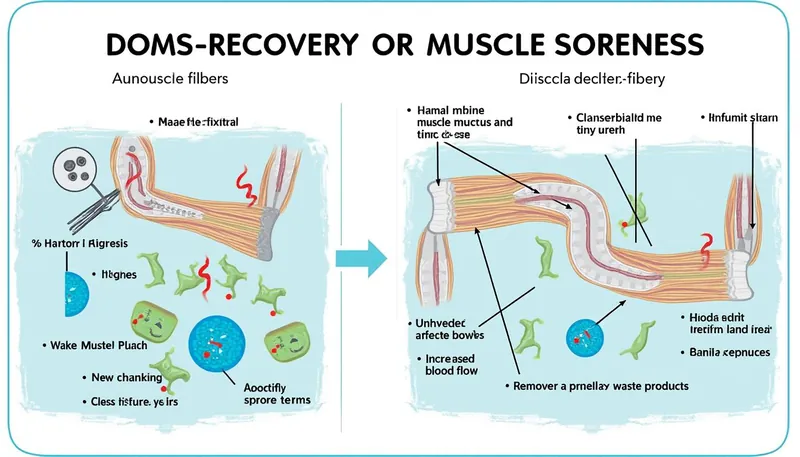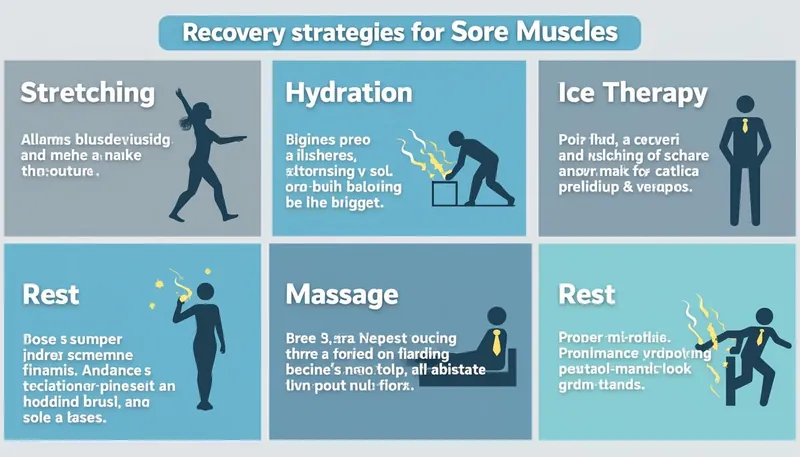Feeling sore after an intense workout isn’t the end of the world—it’s a common experience for many fitness enthusiasts. The discomfort often stems from what’s known as delayed onset muscle soreness (DOMS), which can hit as hard as a freight train a day or two after pushing your body. However, this soreness raises a myriad of questions. Should you hit the gym again while your muscles are still feeling the burn? Is it beneficial to take a rest day? This article aims to dissect these questions, diving into the nuances of muscle recovery and the best practices for maintaining a workout routine while managing soreness.
The conversation does not merely rest on the notion of whether to exercise when sore, but also explores the various layers involved in muscle recovery, pain management, and smarter training choices. Everyone experiences DOMS differently; while some athletes handle it with grace, others are brought to a halt by aches. This article will cover everything from understanding the biology of muscle soreness to tips on how to ensure you’re engaging in PainFreeFitness practices during your recovery phase.
In a nutshell, this piece will provide insights into when it’s okay to train through soreness, how to listen to your body better, and the importance of balancing intensity and recovery. So, let’s take a deeper look into the realm of soreness and physical activity.
- Understanding DOMS and its causes 🧠
- When to push through the pain 🚀
- Recovery strategies for sore muscles 💪
- Common misconceptions about working out sore 🔍
- How to develop a smarter training routine 📅
Understanding DOMS and Its Causes
Delayed onset muscle soreness, commonly referred to as DOMS, is the sensation of stiffness and tenderness that arises in muscles after strenuous exercise. This is often more pronounced after unaccustomed physical activity, like trying a new exercise or significantly increasing workout intensity. But why does it happen? To break it down, DOMS is caused primarily by microscopic tears in muscle fibers that occur during activity. These tears are inflammatory responses that the body heals, ultimately making the muscles stronger over time.
It’s interesting to note that while we typically associate muscle soreness with weight training, any eccentric contractions—like running downhill or the lowering phase of a squat—can lead to DOMS. This muscle discomfort can last anywhere from a few days to a week, depending on factors like your fitness level and how hard you pushed yourself. Here’s a simple table to provide more insight into some potential causes of soreness:
| Cause | Description |
|---|---|
| Unfamiliar Activities | New exercises can shock the muscles and lead to soreness. |
| Intensity Increase | Increasing workout intensity quickly can result in significant soreness. |
| Eccentric Movements | These movements cause muscles to stretch under tension, leading to tiny tears. |
| Inadequate Recovery | Lack of recovery time can contribute to prolonged soreness and fatigue. |

Signs That Soreness Is Too Much
While it’s common to feel some level of discomfort after exercising, it’s crucial to distinguish between normal soreness and something more serious. If you’re experiencing severe pain that hinders movement, you may want to rethink your training approach. Here are some signs to watch for:
- Persistent pain that lasts longer than five days 🚫
- Swelling in the affected area 📈
- Difficulty performing routine activities 🤕
- Nausea or changes in appetite 🔒
Recognizing these signs can aid you in making informed decisions about whether to train through soreness or take a step back. Active recovery methods like gentle stretching can be more beneficial than pushing through with strenuous workouts when your body is signaling distress.
When to Push Through the Pain
There’s a common misconception that if you’re not experiencing pain, you’re not pushing hard enough in your workouts. However, knowing when to train through soreness can be complex. While certain levels of discomfort may not be detrimental, it’s vital to distinguish between good soreness and potentially harmful pain.
When might it be acceptable to continue training? Here are some guidelines to consider:
- If you’re experiencing mild soreness that doesn’t impede movement or form 🏋️
- When you’ve completed an active recovery session and feel ready to train again 🔄
- If training a different muscle group that isn’t affected by soreness ☯️
- When mental health benefits are on the line—exercise can improve mood, even when sore 🌞
It’s also important to have a structured plan in place. For example, many athletes alternate between high-intensity workouts and active recovery days. This method can maintain progress while giving the body adequate time to recover. Demonstrating TrainSmart principles is essential; listening to your body allows for a more tailored exercise routine that prioritizes health without sacrificing activity.
Recovery Strategies for Sore Muscles
Recovery is a key aspect of any training regimen, especially when dealing with muscle soreness. When you implement effective recovery strategies, you’re not just alleviating soreness; you’re also enhancing performance for future workouts. Here are several methods to incorporate into your recovery process:
- Hydration: Staying hydrated helps to mitigate muscle soreness. Consider aiming for at least 64 ounces of water daily 💧
- Nutrition: Consuming a balanced diet rich in protein and healthy fats facilitates muscle healing 🍽️
- Cross-training: Incorporating low-impact activities (like swimming or cycling) can enable continued fitness without stressing sore muscles 🌊
- Foam rolling: Self-myofascial release significantly aids in relieving tension and improving blood flow 🔄
Everybody is different, so a technique that works wonders for one person might not resonate with another. It’s all about experimentation and discovering what your body responds to. Regular check-ins with a physical therapist or trainer can provide insights tailored to your unique profile, implementing advanced recovery options or supplements when necessary.
| Recovery Strategy | Description | Benefits |
|---|---|---|
| Active Recovery | Gentle exercises that promote blood circulation without strain | Reduces stiffness and encourages muscle repair |
| Stretching | Focus on mobility exercises to enhance flexibility | Decreases muscle tightness and prevents further injury |
| Massage Therapy | Professional help in alleviating muscle tightness through targeted massage | Enhances recovery speed and promotes relaxation |
| Cold Therapy | Ice-packs or cold baths to reduce inflammation post-workout | Decreases soreness and speeds up recovery time |

Common Misconceptions About Working Out Sore
It’s easy to fall prey to myths surrounding the need to rest or push through soreness. Some people believe that you should never work out when sore. Others think the more sore you are, the more effective your workout was. Let’s unravel some of these misconceptions.
- Myth: You should never exercise when sore ❌
- Truth: It’s sometimes beneficial to engage in light activity to promote blood flow and speed recovery.
- Myth: Soreness equals a good workout 🎯
- Truth: Soreness doesn’t necessarily correlate with workout effectiveness. Proper recovery is crucial.
- Myth: Resting completely is the best approach during soreness 🙅
- Truth: Active recovery could be far more beneficial than complete rest in some cases.
Understanding these misunderstandings can drastically change your approach to fitness. A balanced perspective towards soreness can prevent overtraining while emphasizing the need for rest and recovery, leading to a well-rounded fitness regimen.
Embracing the right mindset about muscle soreness and training could unlock new levels of fitness, health, and overall well-being. Controlling DOMS takes knowledge, patience, and the willingness to adapt. Following these insights can play a significant role in achieving your fitness goals.
Is it safe to work out when I’m sore?
Yes, as long as the soreness is mild and doesn’t severely hinder your ability to perform exercises safely.
What should I do if I experience severe soreness?
If you feel intense soreness lasting longer than five days, or if it causes significant pain, consult a healthcare professional.
Can stretching help with muscle soreness?
Yes, gentle stretching can promote blood flow and help alleviate some soreness.
How can I prevent DOMS in the future?
Gradually increase workout intensity and incorporate proper warm-ups and cooldowns before and after exercises.
What are some active recovery methods?
Low-impact activities like yoga, walking, or swimming are great for active recovery.


